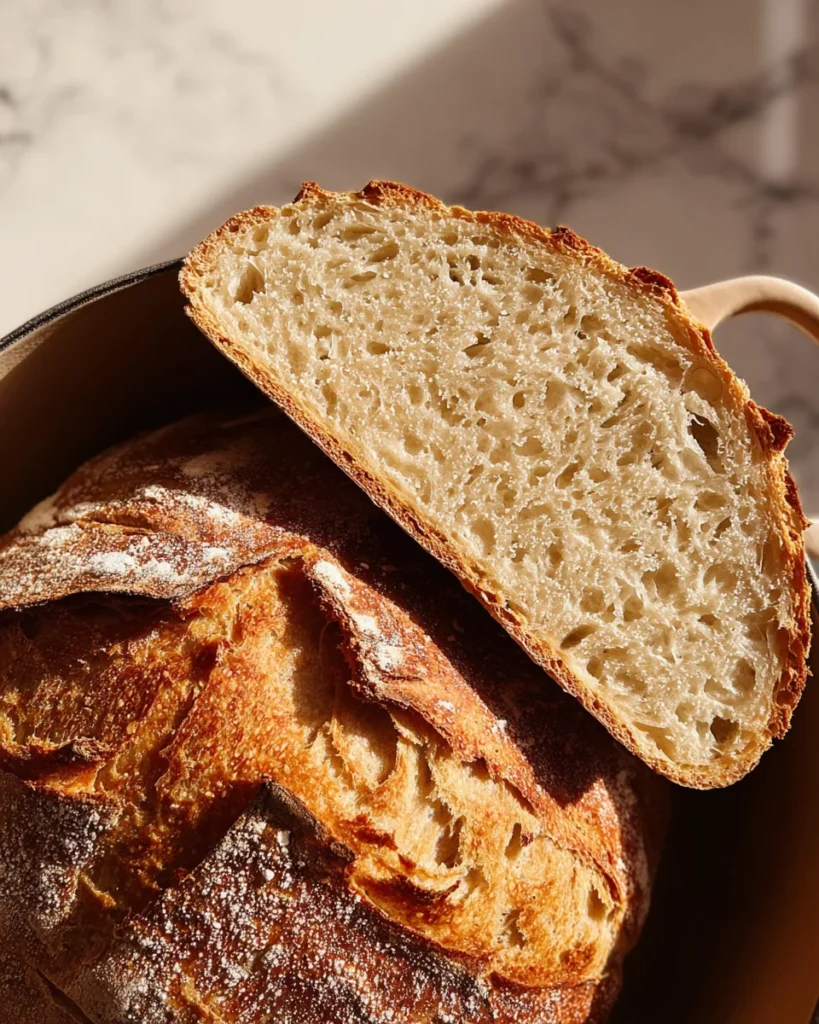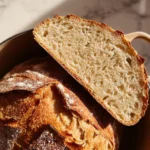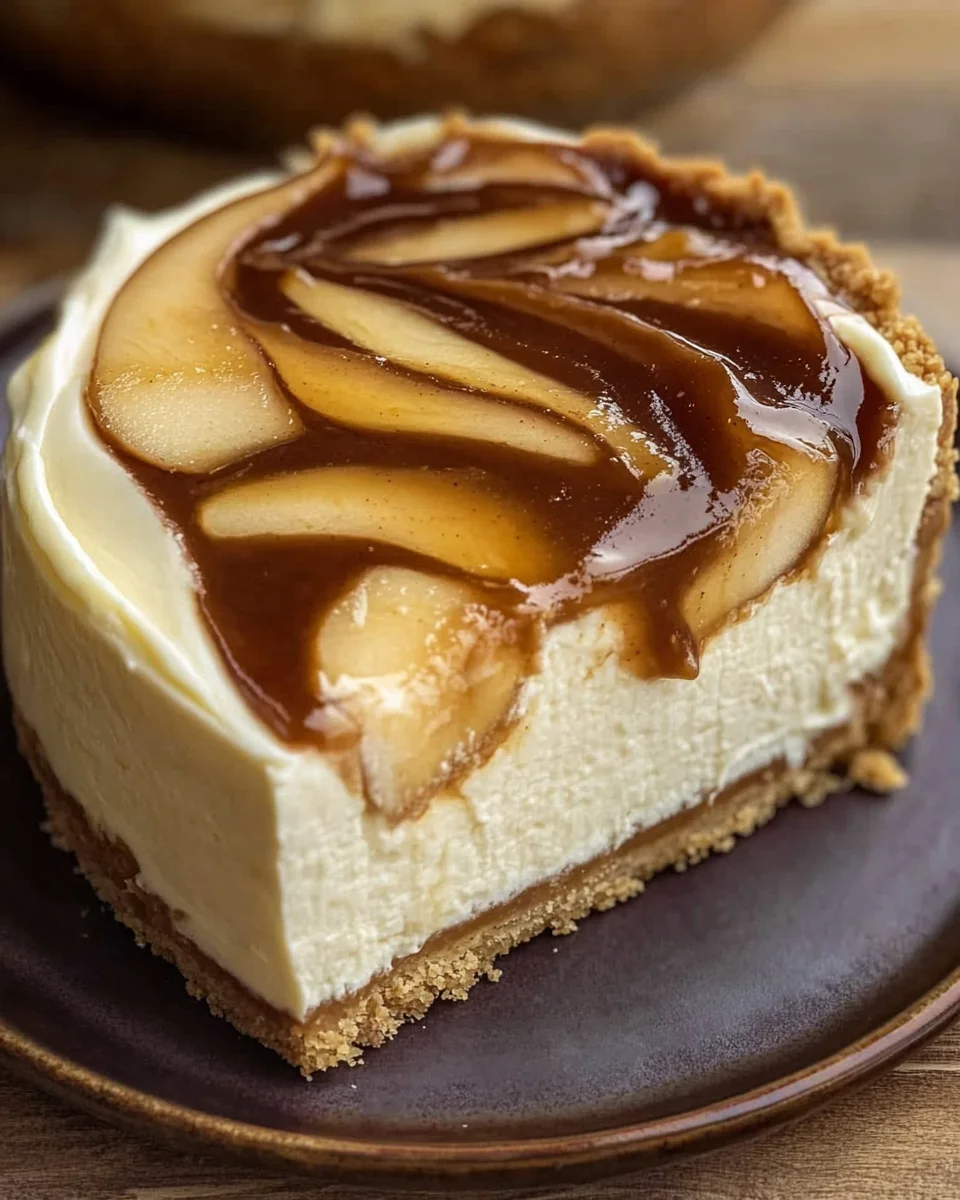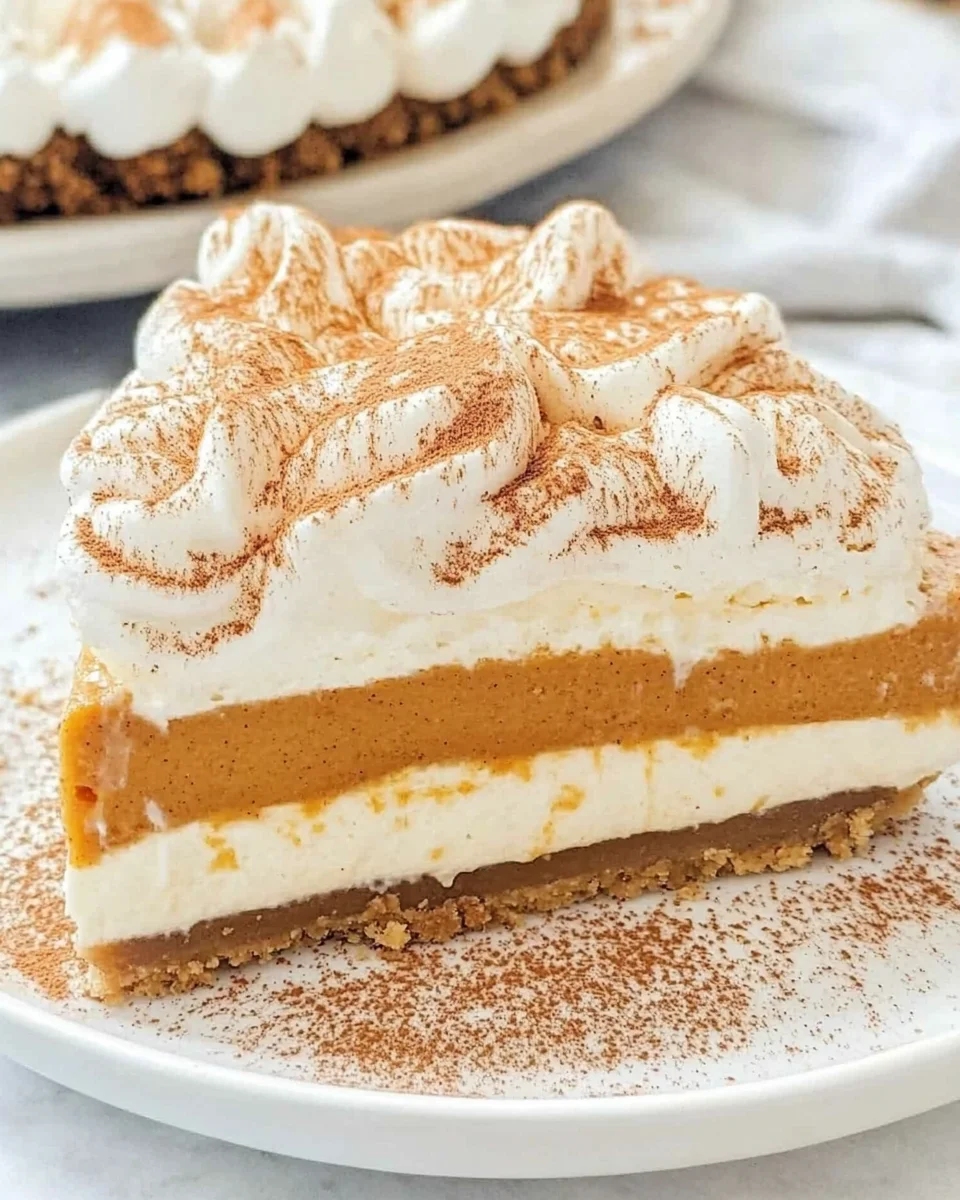This Dutch Oven Sourdough Bread (Master Recipe) is a delightful way to create a beautifully crusty and flavorful loaf right at home. It’s perfect for beginners and experienced bakers alike. The unique qualities of sourdough, combined with the convenience of a Dutch oven, allow you to achieve amazing results. Whether for a family dinner or a special occasion, this recipe will impress everyone at your table.
Why You’ll Love This Recipe
- Simple Steps: This master recipe breaks down the sourdough process into easy-to-follow steps, making it accessible for everyone.
- Versatile Base: Use this recipe as a foundation for different flavors and variations of sourdough bread.
- Delicious Flavor: The slow fermentation process enhances the natural flavors, resulting in a rich and tangy taste.
- Perfect Crust: Baking in a Dutch oven creates steam that gives your bread a golden, crispy crust every time.
- Impressive Presentation: The beautiful boule shape makes this loaf perfect for serving at gatherings or as a gift.
Tools and Preparation
Gathering the right tools is essential for making your Dutch Oven Sourdough Bread. Having everything ready will streamline the process and enhance your baking experience.
Essential Tools and Equipment
- Dutch oven
- Large mixing bowl
- Spray bottle filled with water
- Clean countertop or work surface
- Parchment paper
Importance of Each Tool
- Dutch oven: Traps steam while baking, creating that perfect crust and helping the bread rise beautifully.
- Mixing bowl: Provides ample space to combine ingredients without mess, crucial for kneading and resting dough.
Ingredients
This Dutch oven sourdough bread recipe is perfect for beginners. Learn how to make a classic Dutch oven sourdough boule. This is my master recipe for Dutch oven sourdough bread, which means you can use this as a base recipe for any sourdough bread you want to make.
For the Dough:
- 500 grams Organic Bread Flour
- 300 grams Water
- 100 grams Sourdough Starter
- 10-15 grams Sea Salt
How to Make Dutch Oven Sourdough Bread (Master Recipe)
Step 1: Prepare Your Ingredients
Start by gathering all your ingredients. It’s essential to have everything measured out before you begin.
Step 2: Mix the Dough
In a large bowl, combine the sourdough starter, flour, salt, and water. Mix until everything forms a cohesive dough ball.
Step 3: Knead the Dough
Knead the ingredients together until you have a uniform dough ball. This helps develop gluten which is vital for structure.
Step 4: First Stretch and Fold
Using your spray bottle, mist your clean countertop lightly with water. Wet your hands and the top of the dough ball before turning it out onto the wet counter.
- Stretch the top over the bottom.
- Fold side over side.
- Fold bottom over top.
- Place back in the bowl seam side down and let rest for 30 minutes.
Step 5: Repeat Stretching and Folding
Repeat misting your countertop and stretching/folding three more times at intervals of 2 hours each:
- Mist surface again.
- Wet hands and surface of dough.
- Turn out onto wet counter; stretch and fold as before.
- Rest seam side down in bowl after each fold.
Step 6: Pre-shape the Dough
Clean your work surface. Sprinkle flour on it, then gently flip your dough onto it so it’s seam side up.
- Gently stretch out and fold again (side over side, top over bottom).
- Flip it seam side down on the counter.
- Form into a circular shape; cover with a tea towel and let rest for 1 hour.
Step 7: Final Shaping
After resting, sprinkle flour on top of your pre-shaped dough again and flip it seam side up once more.
- Stretch out gently; fold again as before.
- Tuck under parts needed to form a nice round loaf shape.
- Coat proofing basket with flour; place dough smooth side down.
Step 8: Cold Fermentation
Cover your proofing basket with plastic wrap or cloth and place in fridge overnight for 8-12 hours.
Step 9: Preheat Your Oven
After fermentation, preheat your Dutch oven with its lid in an oven set to 450°F (232°C).
Step 10: Bake Your Bread
Carefully remove hot Dutch oven from oven once preheated:
- Place parchment paper on counter; turn dough out seam side down.
- Score with sharp knife or scoring tool.
- Lift parchment paper corners to transfer dough into hot Dutch oven safely.
- Cover with lid; bake for 30 minutes at 450°F (232°C).
- Remove lid; bake uncovered for another 20-30 minutes until golden brown.
Step 11: Cool Before Slicing
Once baked, carefully remove loaf from Dutch oven and allow it to cool on a wire rack for at least an hour before slicing into it.
Enjoy your delicious homemade Dutch Oven Sourdough Bread!
How to Serve Dutch Oven Sourdough Bread (Master Recipe)
Serving your freshly baked Dutch Oven Sourdough Bread is a delightful experience. There are many ways to enjoy this crusty and flavorful bread, whether as a simple slice or part of an elaborate dish.
With Butter and Jam
- Spread a generous layer of butter on warm slices for a rich taste.
- Add your favorite jam for a sweet contrast that elevates breakfast.
As Toast
- Toast slices until golden brown for a crunchy texture.
- Top with avocado and a sprinkle of salt for a hearty snack.
In Sandwiches
- Use the bread to create sandwiches filled with meats, cheeses, or veggies.
- Try a classic grilled cheese for a comforting meal.
With Soup
- Pair your sourdough with a warm bowl of soup, like tomato or minestrone.
- The bread is perfect for dipping, soaking up flavors beautifully.
As Croutons
- Cube leftover bread and bake until crispy to make croutons.
- Toss them in salads for added crunch and flavor.
With Cheese Board
- Serve alongside an assortment of cheeses, nuts, and fruits.
- It complements various flavors, making it ideal for gatherings.
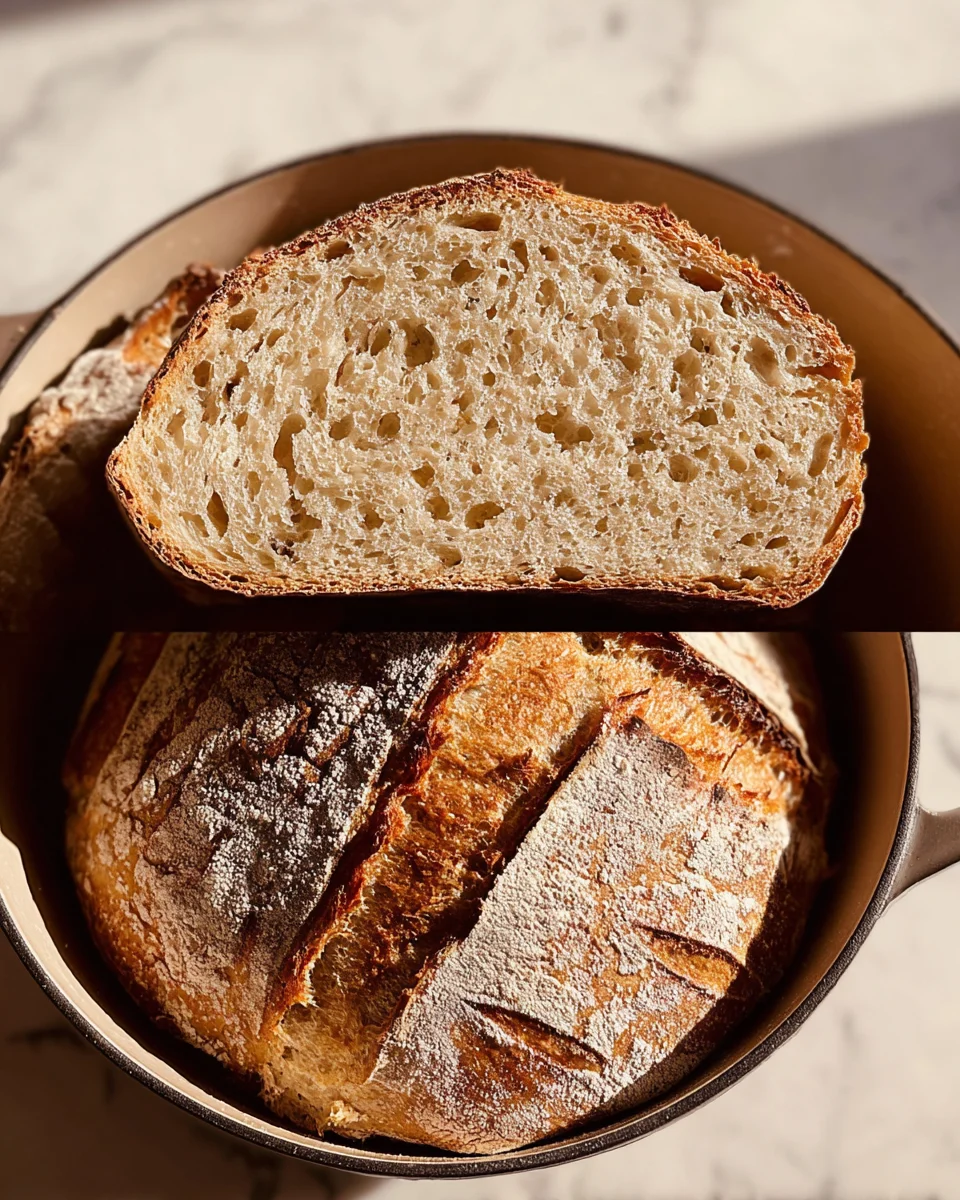
How to Perfect Dutch Oven Sourdough Bread (Master Recipe)
Perfecting Dutch Oven Sourdough Bread requires attention to detail and practice. Here are some tips to help you achieve the best results.
- Use a digital scale: Measuring ingredients accurately ensures consistent results every time.
- Maintain hydration: Keep dough appropriately hydrated for better texture and crumb structure.
- Practice stretching and folding: This technique builds gluten strength without traditional kneading.
- Allow proper fermentation: Letting the dough rise at room temperature enhances flavor development.
- Preheat your Dutch oven: A well-heated pot creates the perfect environment for crust formation.
- Cool before slicing: Allowing the bread to cool fully helps set the crumb and improves slice quality.
Best Side Dishes for Dutch Oven Sourdough Bread (Master Recipe)
Dutch Oven Sourdough Bread pairs beautifully with several side dishes, enhancing its flavor profile. Consider these delicious options to serve alongside your loaf.
- Creamy Tomato Soup: A classic pairing that balances acidity with richness—perfect for dunking!
- Mixed Green Salad: Fresh greens dressed in vinaigrette offer crispness that complements the bread’s texture.
- Roasted Vegetables: Seasonal vegetables roasted until caramelized provide sweetness that contrasts nicely.
- Cheese Platter: A selection of cheeses adds variety; try sharp cheddar or creamy brie with your sourdough.
- Garlic Butter Shrimp: Juicy shrimp sautéed in garlic butter create an indulgent side to enjoy with slices of bread.
- Potato Wedges: Crispy potato wedges seasoned to perfection make for a hearty pairing that everyone loves.
- Hummus Dip: A smooth hummus serves as a healthy spread, offering proteins alongside your sourdough delight.
- Charcuterie Board: A mix of cured meats adds savory notes that pair wonderfully with the rustic flavors of sourdough.
Common Mistakes to Avoid
Making Dutch oven sourdough bread can be a rewarding experience, but beginners often face some common pitfalls. Here are mistakes to watch out for:
Skipping the Starter Check: Always ensure your sourdough starter is active and bubbly before using it. If it’s not, your bread won’t rise properly.
Ignoring Temperature: Dough thrives in warm conditions. If your kitchen is too cold, fermentation slows down, leading to dense bread. Try placing the dough in a slightly warm area to promote rising.
Overworking the Dough: Kneading too much can lead to tough bread. Aim for a uniform dough ball without excessive kneading. Gentle handling preserves the air bubbles needed for a light loaf.
Neglecting Rest Time: Allowing the dough to rest is crucial for flavor and texture. Skipping or shortening these times will result in bread that lacks depth and chewiness.
Underestimating Baking Time: Every oven behaves differently. Ensure you check for doneness by tapping the bottom of the loaf; it should sound hollow when cooked through.
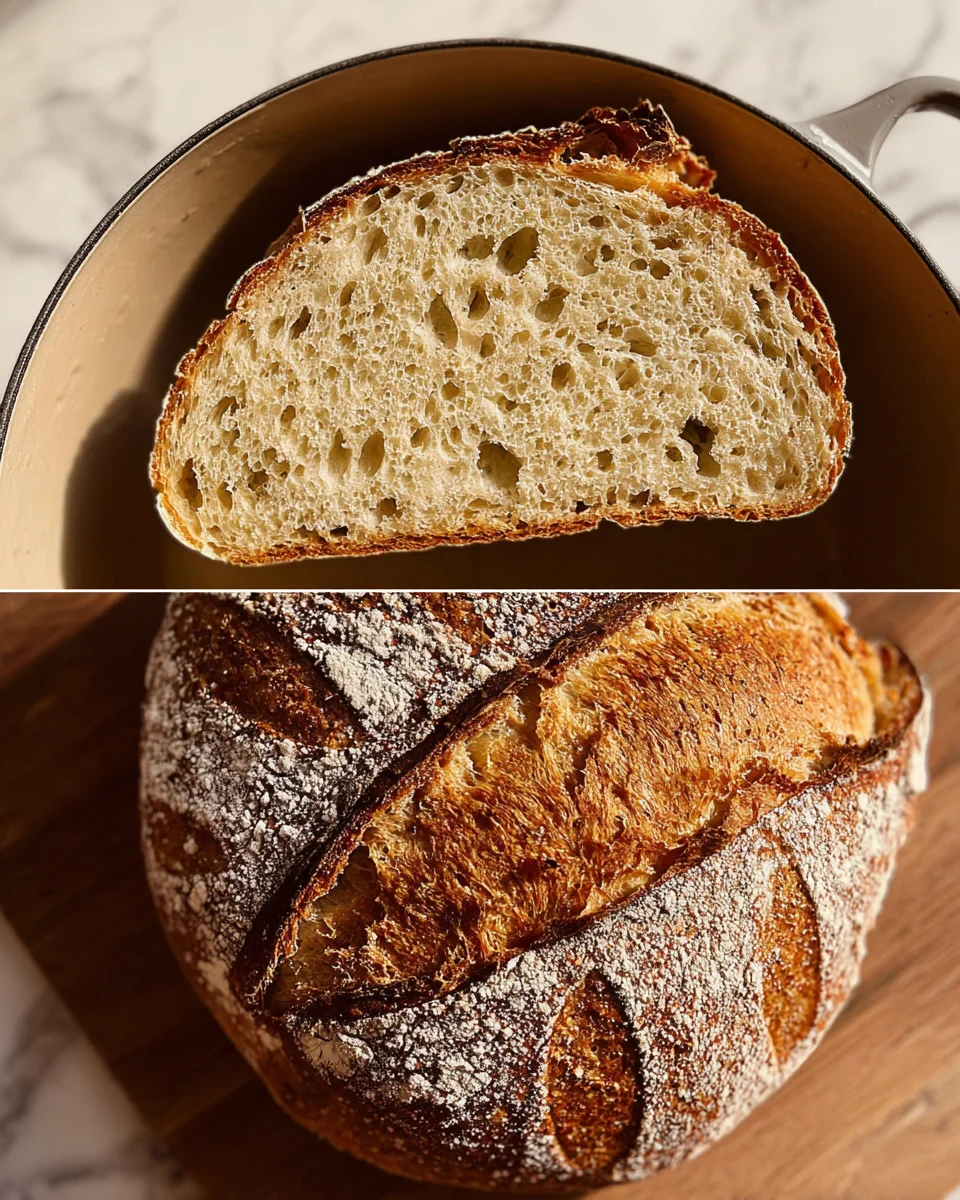
Storage & Reheating Instructions
Refrigerator Storage
- Store your Dutch oven sourdough bread in a paper bag or wrapped in a clean kitchen towel. This prevents moisture buildup while keeping it fresh.
- It will stay fresh for up to 3 days in the refrigerator.
Freezing Dutch Oven Sourdough Bread (Master Recipe)
- Wrap your cooled loaf tightly in plastic wrap followed by aluminum foil before freezing to prevent freezer burn.
- It can be frozen for up to 3 months. Thaw at room temperature before serving.
Reheating Dutch Oven Sourdough Bread (Master Recipe)
- Oven: Preheat your oven to 350°F (175°C). Place the bread directly on the rack for about 10-15 minutes until warmed through.
- Microwave: Wrap slices in a damp paper towel and microwave for about 10-15 seconds. Be careful not to dry them out.
- Stovetop: Heat a skillet over medium-low heat. Place slices in the skillet, cover with a lid, and heat for about 2-3 minutes on each side.
Frequently Asked Questions
What makes Dutch Oven Sourdough Bread (Master Recipe) unique?
This master recipe allows flexibility; you can experiment with different flours and add-ins while still achieving that classic sourdough flavor and crust.
How long does it take to make Dutch Oven Sourdough Bread?
From start to finish, this recipe takes about 7 hours and 20 minutes, including resting times. Patience is key!
Can I use all-purpose flour instead of bread flour?
Yes! However, using bread flour provides better gluten structure, leading to a chewier texture, which is ideal for sourdough.
Is it necessary to use a proofing basket?
While it’s not mandatory, using a proofing basket helps shape your loaf and creates beautiful patterns on the crust once baked.
Final Thoughts
This Dutch oven sourdough bread recipe is both simple and versatile, making it an excellent choice for new bakers. You can customize it with herbs or spices, ensuring every loaf is uniquely yours. Give this master recipe a try; you’ll love the comfort of homemade sourdough!
Dutch Oven Sourdough Bread (Master Recipe)
Elevate your baking skills with this Dutch Oven Sourdough Bread, a master recipe designed for both beginners and seasoned bakers. Enjoy the satisfaction of creating a beautifully crusty, artisanal loaf right in your kitchen. The slow fermentation process captures the tangy essence of sourdough while the Dutch oven ensures an impeccable golden crust. Perfect for family meals or special gatherings, this sourdough bread will impress everyone at your table. Plus, it serves as an excellent base for endless flavor variations—let your creativity shine!
- Prep Time: 30 minutes
- Cook Time: 50 minutes
- Total Time: 1 hour 20 minutes
- Yield: Approximately 12 servings
- Category: Bread
- Method: Baking
- Cuisine: Dutch
Ingredients
- 500 grams Organic Bread Flour
- 300 grams Water
- 100 grams Sourdough Starter
- 10-15 grams Sea Salt
Instructions
- Prepare Ingredients: Measure all ingredients accurately before starting.
- Mix Dough: Combine sourdough starter, flour, salt, and water in a large bowl until a cohesive dough forms.
- Knead Dough: Knead gently until uniform; avoid overworking to maintain texture.
- Stretch & Fold: Mist countertop with water, stretch the dough over itself four times at intervals of 2 hours.
- Pre-shape & Final Shape: Shape into a round loaf and place seam side down in a floured proofing basket.
- Cold Fermentation: Cover and refrigerate overnight (8-12 hours).
- Preheat Oven: Heat Dutch oven to 450°F (232°C).
- Bake Bread: Score dough and transfer to the hot Dutch oven; cover and bake for 30 minutes, then uncover for an additional 20-30 minutes until golden brown.
- Cool: Let the loaf cool on a wire rack for at least an hour before slicing.
Nutrition
- Serving Size: 1 slice (50g)
- Calories: 130
- Sugar: 0g
- Sodium: 300mg
- Fat: 0.5g
- Saturated Fat: 0g
- Unsaturated Fat: 0g
- Trans Fat: 0g
- Carbohydrates: 27g
- Fiber: 1g
- Protein: 4g
- Cholesterol: 0mg
